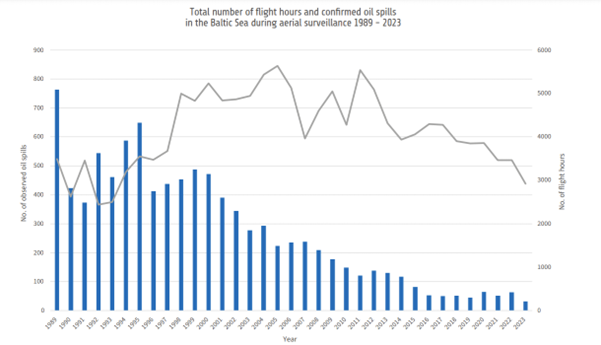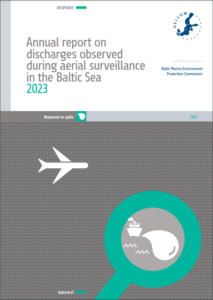Last year, only 32 harmful spills of mineral oil were detected in the Baltic Sea, according to a new HELCOM report. This marks a significant long-term decrease, compared to the 763 pollution occurrences reported in 1989, the first year of aerial surveillance.
The decline in detected oil spills, despite increased shipping and more intensive aerial surveillance, is likely due to a higher number of flight hours and the broader use of remote sensing equipment, such as Side Looking Airborne Radar (SLAR). Enhanced monitoring likely deters ships from making illegal discharges. Satellite surveillance also complements aerial efforts by covering larger areas and improving overall effectiveness of flights.

In 2023, Baltic Sea countries conducted 2,920 hours of aerial surveillance flights, the lowest number since the mid-1990s. This reduction was due to maintenance and technical issues, along with organizational changes in some countries. It is not unusual for the number of flight hours to vary each year during the regular regional aerial surveillance activities. Additionally, the flight hours reported only account for fixed-wing aircraft, excluding helicopters and drones to maintain consistency in long-term statistics. Aerial surveillance by helicopters and flights has been reported separately since 2019.
The key findings of the HELCOM Annual report on discharges observed during aerial surveillance in the Baltic Sea, 2023 can be explored via an interactive data visualization dashboard developed by the HELCOM Secretariat using Power BI. This tool provides users with a more detailed and analytical view of the aerial surveillance datasets since 1998.
Data on individual oil spills can also be viewed and downloaded from the HELCOM Map and data service (HELCOM MADS).
Aerial surveillance and response to spills in the Baltic Sea
Cooperation on aerial surveillance within the Baltic Sea area was established in the 1980s under the framework of HELCOM. The primary aim of regional aerial surveillance is to detect spills of oil and other harmful substances, thereby preventing violations of regulations on pollution from ships. These spills pose a significant threat to the marine environment of the Baltic Sea area. When possible, the source of pollution should be established, and samples of the spill should be taken from both the sea surface and the suspected offender to enable prosecution.
To monitor these commitments and to provide an overview of the situation in the region, the HELCOM Secretariat compiles annual data on discharges observed in the Baltic Sea area during national and jointly coordinated aerial surveillance activities. The HELCOM Expert Group on Aerial Surveillance (EG Surveillance) is responsible for implementing the aerial surveillance cooperation and commitments.
Read the report

